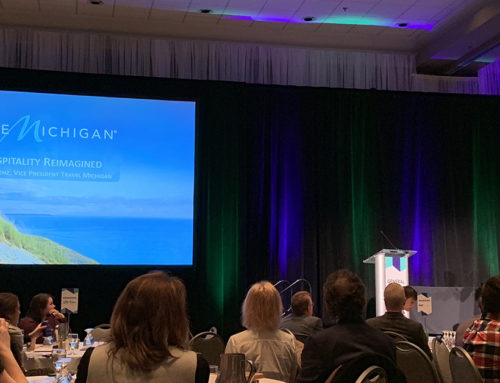 When the Temperatures Drop our Spirits Rise in Northern Michigan Wine Country.
When the Temperatures Drop our Spirits Rise in Northern Michigan Wine Country.
Germany is known for their Eiswein, and so is Canada. But did you know that Michigan has been turning frozen grapes into liquid luxury since 1983? When you learn a bit about the process you’ll understand why ice wine is worth it’s weight in gold.
A true ice wine is made from grapes left on the vine until harvest and pressed while frozen. Each year winemakers must decide whether or not to gamble on producing an ice wine. Growers take quite a risk leaving grapes on the vine after the fall harvest. It’s not only a risk to the crop but to the vine itself. According to Chris Lopez of Black Star Farms, grapes left to ripen past harvest require so much energy from the vine and the roots which sustain it, that it can cause a smaller harvest in subsequent years or possible loss of the vine itself.

Upon picking the grapes are as hard as marbles. They are brought to the winery and pressed outside in old-fashioned wooden basket presses. The frozen block takes days to squeeze a thicky syrupy liquid as each grape will yield not much more than a drop. The frozen block is then painstakingly removed from the basket by hand.
 This year Black Star Farms harvested 6000 pounds of ice wine grapes, which produced 125 gallons of juice, or roughly 110 cases of ice wine. That may sound like a lot, but it’s actually only 25% of a normal yield. In other words, had those same grapes been picked in the fall they would have produced 500 gallons of juice. When you factor in the potential loss of grapes, the perfect conditions required for harvest and the additional labor, it’s easy to see why ice wines are so valuable, or as some might say, expensive. But once you’ve had a sip of this deliciously sweet nectar from the vine you’ll know it’s also worth every cent.
This year Black Star Farms harvested 6000 pounds of ice wine grapes, which produced 125 gallons of juice, or roughly 110 cases of ice wine. That may sound like a lot, but it’s actually only 25% of a normal yield. In other words, had those same grapes been picked in the fall they would have produced 500 gallons of juice. When you factor in the potential loss of grapes, the perfect conditions required for harvest and the additional labor, it’s easy to see why ice wines are so valuable, or as some might say, expensive. But once you’ve had a sip of this deliciously sweet nectar from the vine you’ll know it’s also worth every cent.
Black Star Farms A Capella ice wine has taken taken several medals and has been served in presidential dinners hosted at The White House. Ice wines are fantastic when aged, even 20 years or more. For Lee Lutes the ability to age an ice wine makes it that much more valuable. His 2002 vintage, an especially prosperous harvest for local ice wine, is one he’s saving to share with his daughter as they share the same birth year.
Click here to check out this video of the 2007 Ice Wine harvest at Black Star Farms, produced in conjunction with Absolute Michigan.
 Another local winemaker experimenting with ice wine production is Shawn Walters of Forty-Five North Vineyard & Winery. Their vineyard is very young, and not currently producing enough fruit to offer a true ice wine. They are however creating an Icebox wine. So what’s the difference? An icebox wine, or Vin de Glaciere, is wine made from grapes frozen in an icebox, rather than naturally on the vine. This style eliminates the risk of crop loss, allows for production not dependent on the weather and therefore costs much less. A bottle of Forty-Five North Icebox Pinot Gris sells for $45 for 375ml, as compared to $60-$90 for naturally produced ice wines. There’s much debate as to whether or not the quality of the wine is better one way or another. But most will agree, it’s not Ice Wine unless it’s frozen on the vine.
Another local winemaker experimenting with ice wine production is Shawn Walters of Forty-Five North Vineyard & Winery. Their vineyard is very young, and not currently producing enough fruit to offer a true ice wine. They are however creating an Icebox wine. So what’s the difference? An icebox wine, or Vin de Glaciere, is wine made from grapes frozen in an icebox, rather than naturally on the vine. This style eliminates the risk of crop loss, allows for production not dependent on the weather and therefore costs much less. A bottle of Forty-Five North Icebox Pinot Gris sells for $45 for 375ml, as compared to $60-$90 for naturally produced ice wines. There’s much debate as to whether or not the quality of the wine is better one way or another. But most will agree, it’s not Ice Wine unless it’s frozen on the vine.
Not to be left out in the cold, so to speak, winemaker Bryan Ulbrich of Left Foot Charley will produce a very limited supply of ice wine with a 2008 vintage. His Vidal Blanc Icewine, produced from a grape hybridized specifically for ice wine, came from the vineyards at the Gray Hare Inn. It took three days of pressing to produce 22 gallons of juice. He uses a small basket press, operated by hand-crank, “we walked around it like a bunch of mules,” he joked. Talk about a labor of love. And if you think this year’s production of 20 cases is small, ask him how much he produced last year! When asked why he doesn’t use Riesling he said they just don’t have enough grapes to risk on ice wine. “Vidal Blanc was made for ice wine,” he explained. I guess you can’t argue with that.
 The 2008 harvest looks promising on all accounts. Black Star Farms will release their ’08 A Capella in the spring. Forty-Five North is selling the last of the 2007 Icebox Pinot Gris, and will release a ’08 Icebox Riesling later this winter. The riesling, a bit of an experiment for Walters, is currently fermenting in French oak barrels, like a Chardonnay. He hopes this will impart a subtle vanilla with earthy undertones. Walters also produced a true ice wine for Longview Winery, Sweet Winter Ice, from the Cayuga grape.
The 2008 harvest looks promising on all accounts. Black Star Farms will release their ’08 A Capella in the spring. Forty-Five North is selling the last of the 2007 Icebox Pinot Gris, and will release a ’08 Icebox Riesling later this winter. The riesling, a bit of an experiment for Walters, is currently fermenting in French oak barrels, like a Chardonnay. He hopes this will impart a subtle vanilla with earthy undertones. Walters also produced a true ice wine for Longview Winery, Sweet Winter Ice, from the Cayuga grape.
Check out our new Michigan Ice Wine photo gallery for more images from Forty-Five North and Longview Winery’s ice wine harvest.
Photos courtesy of Black Star Farms and Forty-Five North Vineyard & Winery
For more information on the history of Michigan ice wines check out these links:
Detroit News – Record number of Michigan wineries make ice wine in 2002 vintage The Wine Report, January, 2003, by Sandra Silfven
FindArticles – Michigan ice wine rises when mercury falls Wines & Vines, July, 2006, by Todd Spencer






Leave A Comment